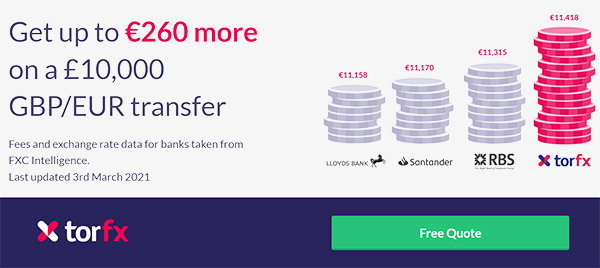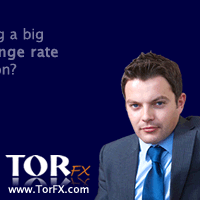Euro to Dollar FX Forecast in 12 Months: 1.15 say BNP Paribas
January 21, 2024 - Written by John Cameron

Foreign exchange strategists at BNPP expect the Euro to Dollar exchange rate will strengthen to 1.15 at the end of 2024 as the dollar losses ground and the Euro is resilient in global markets.
In contrast, HSBC expects that the pair will weaken to 1.05 as confidence in the Euro erodes again.
The dollar was boosted during the week by fading expectations of a March interest rate cut with the March decision now considered a toss-up. In this environment, EUR/USD lost ground during the week, but did find support below 1.0850 and settled around 1.0875.
US interest rate trends will remain a key element over the next few months.
ING does not back a March rate cut; “we really struggle to imagine the Fed cutting in two months’ time against the current economic backdrop.”
The bank added; “We retain a 1.1500 end-year forecast for EUR/USD but see range trading in the near term.”
BNPP maintains a bearish stance on the dollar. It noted; “with core PCE now closing in on the Fed’s target, the emphasis will shift to the other half of the dual mandate – the labour market. As a result, we think the market will be more sensitive to downside than upside employment prints from now on.”

BNPP added; “We do not think that a material downturn is a precursor for cuts; rather, the Fed could reduce the policy rate before data sour in order to achieve a soft landing. This would remove the safe-haven aspect of the USD that has typically resulted in it rising during prior slowdowns and allow narrowing interest rate differentials to weigh on the USD”
HSBC is also doubtful that the fundamentals justify notable dollar losses; “The consensus is banking on the USD to come last, as the Fed’s cutting cycle unfolds. We disagree with this thinking.”
It adds; “The conditions for this to occur are not in place, in our view. HSBC Economics’ base case is for global growth to remain soft, rather than turn for the better. The Fed’s pivot could also soon be followed by other central banks that have not yet done so, namely the ECB and BoE.”
US retail sales data was slightly stronger than expected with a 0.6% December increase compared with expectations of a 0.3% increase.
Initial jobless claims also declined to 187,000 in the latest week from 203,000 previously and the lowest reading for over 12 months.
The data overall triggered doubts whether a March rate cut was realistic with markets pricing in around a 55% chance of a cut from just over 80% the previous week.
CIBC commented on the US retail sales data; All in all, today's report reinforces our view that the Fed is no hurry to cut rates and policy easing will only begin in the second half of the year.

The US also reported a slump in the New York manufacturing survey while the Philadelphia index remained in contraction territory.
SocGen is still concerned over US manufacturing trends. It noted; “when manufacturing companies worry about their order books and hire less (or fire more), the local bars, restaurants and airports all feel the effects.”
BNPP remains broadly positive on the Euro; “Our optimism is derived from several factors, but first and foremost, it reflects our view that markets are overly pessimistic on eurozone growth and hence are pricing in too many ECB rate cuts.”
Credit Agricole expects that underlying inflation is likely to weaken further; “The Governing Council could thus downplay any transitory spikes of cost-push inflation on the back of geopolitical risks as long as they do not impact the downtrend in core inflation and inflation expectations.”
It added that rate differentials could move against the Euro; “Moreover, the ECB is expected to accelerate its QT in the coming months, suggesting that the bank could maintain a relatively restrictive monetary policy stance with lower policy rates than before. In contrast, a potential deceleration of the Fed’s QT could mean that it can ease monetary conditions with less aggressive rate cuts.”
Credit Agricole also noted external risks; In the absence of any meaningful hawkish surprises, EUR/USD could remain vulnerable to any further deterioration of risk sentiment on the back of tighter global financial conditions in the near term.
In this context, Middle East developments will be monitored closely. Any further deterioration and upward pressure on energy prices would tend to undermine the Euro.
Danske Bank expects tighter financial conditions will favour the dollar; “We maintain our case of a strategic case for a lower EUR/USD in the medium term. While our forecast for the Fed and the ECB suggests upside risk to the cross in Q1, we stress that a broader central bank pricing could prove to be more crucial for EUR/USD. We therefore see levels above 1.10 as temporary.”
It has a 12-month forecast of 1.05.
STORY LINK Euro to Dollar FX Forecast in 12 Months: 1.15 say BNP Paribas

Foreign exchange strategists at BNPP expect the Euro to Dollar exchange rate will strengthen to 1.15 at the end of 2024 as the dollar losses ground and the Euro is resilient in global markets.
In contrast, HSBC expects that the pair will weaken to 1.05 as confidence in the Euro erodes again.
The dollar was boosted during the week by fading expectations of a March interest rate cut with the March decision now considered a toss-up. In this environment, EUR/USD lost ground during the week, but did find support below 1.0850 and settled around 1.0875.
US interest rate trends will remain a key element over the next few months.
ING does not back a March rate cut; “we really struggle to imagine the Fed cutting in two months’ time against the current economic backdrop.”
The bank added; “We retain a 1.1500 end-year forecast for EUR/USD but see range trading in the near term.”
BNPP maintains a bearish stance on the dollar. It noted; “with core PCE now closing in on the Fed’s target, the emphasis will shift to the other half of the dual mandate – the labour market. As a result, we think the market will be more sensitive to downside than upside employment prints from now on.”

BNPP added; “We do not think that a material downturn is a precursor for cuts; rather, the Fed could reduce the policy rate before data sour in order to achieve a soft landing. This would remove the safe-haven aspect of the USD that has typically resulted in it rising during prior slowdowns and allow narrowing interest rate differentials to weigh on the USD”
HSBC is also doubtful that the fundamentals justify notable dollar losses; “The consensus is banking on the USD to come last, as the Fed’s cutting cycle unfolds. We disagree with this thinking.”
It adds; “The conditions for this to occur are not in place, in our view. HSBC Economics’ base case is for global growth to remain soft, rather than turn for the better. The Fed’s pivot could also soon be followed by other central banks that have not yet done so, namely the ECB and BoE.”
US retail sales data was slightly stronger than expected with a 0.6% December increase compared with expectations of a 0.3% increase.
Initial jobless claims also declined to 187,000 in the latest week from 203,000 previously and the lowest reading for over 12 months.
The data overall triggered doubts whether a March rate cut was realistic with markets pricing in around a 55% chance of a cut from just over 80% the previous week.
CIBC commented on the US retail sales data; All in all, today's report reinforces our view that the Fed is no hurry to cut rates and policy easing will only begin in the second half of the year.

The US also reported a slump in the New York manufacturing survey while the Philadelphia index remained in contraction territory.
SocGen is still concerned over US manufacturing trends. It noted; “when manufacturing companies worry about their order books and hire less (or fire more), the local bars, restaurants and airports all feel the effects.”
BNPP remains broadly positive on the Euro; “Our optimism is derived from several factors, but first and foremost, it reflects our view that markets are overly pessimistic on eurozone growth and hence are pricing in too many ECB rate cuts.”
Credit Agricole expects that underlying inflation is likely to weaken further; “The Governing Council could thus downplay any transitory spikes of cost-push inflation on the back of geopolitical risks as long as they do not impact the downtrend in core inflation and inflation expectations.”
It added that rate differentials could move against the Euro; “Moreover, the ECB is expected to accelerate its QT in the coming months, suggesting that the bank could maintain a relatively restrictive monetary policy stance with lower policy rates than before. In contrast, a potential deceleration of the Fed’s QT could mean that it can ease monetary conditions with less aggressive rate cuts.”
Credit Agricole also noted external risks; In the absence of any meaningful hawkish surprises, EUR/USD could remain vulnerable to any further deterioration of risk sentiment on the back of tighter global financial conditions in the near term.
In this context, Middle East developments will be monitored closely. Any further deterioration and upward pressure on energy prices would tend to undermine the Euro.
Danske Bank expects tighter financial conditions will favour the dollar; “We maintain our case of a strategic case for a lower EUR/USD in the medium term. While our forecast for the Fed and the ECB suggests upside risk to the cross in Q1, we stress that a broader central bank pricing could prove to be more crucial for EUR/USD. We therefore see levels above 1.10 as temporary.”
It has a 12-month forecast of 1.05.
International Money Transfer? Ask our resident FX expert a money transfer question or try John's new, free, no-obligation personal service! ,where he helps every step of the way, ensuring you get the best exchange rates on your currency requirements.
TAGS: Euro Dollar Forecasts
Comments are currrently disabled
Related Stories:
- Euro to Dollar Price Forecast: Steady Around 1.15, Momentum Holding - June 20, 2025
- Euro to Dollar FX Forecast: Trend Bullish Despite Modest Pullback - June 19, 2025
- Euro to Dollar Tech Forecast: 1.1480 Key Level to Watch say UoB - June 17, 2025
- Euro to Dollar Rate Forecasted Further Gains as EUR Nears 43-Month Best - June 17, 2025
- Euro to Dollar Forecast: 1.16 by 2026, 1.20 by 2027 say Investment Bank - June 15, 2025
- Euro to Dollar Forecast: EUR Tumbles After Israel Strike on Iran - June 13, 2025
- Euro to Dollar Price Forecast: EUR Surges to 43-Month Best vs USD - June 12, 2025
- Euro to US Dollar Forecast: EUR Targets 1.15 as USD Bears Wait - June 11, 2025
- Euro to Dollar Forecast: EUR to See "1.1370-1.1430 Range Today" - June 10, 2025
Latest News:
- Pound Rate Today: Short Covering Underpins GBP vs EUR, USD - June 20, 2025
- Pound to Dollar Rate "Neutral-Bullish" Following BoE Rate Hold - June 20, 2025
- Pound Sterling Dips vs Euro and Dollar on 6-3 Vote, August Cut Done Deal - June 20, 2025
- Euro to Dollar Price Forecast: Steady Around 1.15, Momentum Holding - June 20, 2025
- Pound-to-Euro Rate Steady Despite BoE's Pill Joining "Team Cut" - June 20, 2025
- Euro to Dollar FX Forecast: Trend Bullish Despite Modest Pullback - June 19, 2025
- Pound to Dollar Forecast: Sustained USD Buying Still Lacking - June 19, 2025
- Euro to Pound Sterling Forecast: 0.860 "on Cards" if no BoE Surprise - June 19, 2025
- GBP/EUR Forecast: Pound Unmoved Against Euro After UK and Eurozone CPI - June 19, 2025
- GBP/USD Forecast: Pound Price Finds Support as UK Inflation Remains Elevated - June 19, 2025








